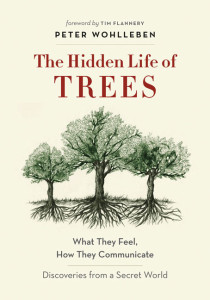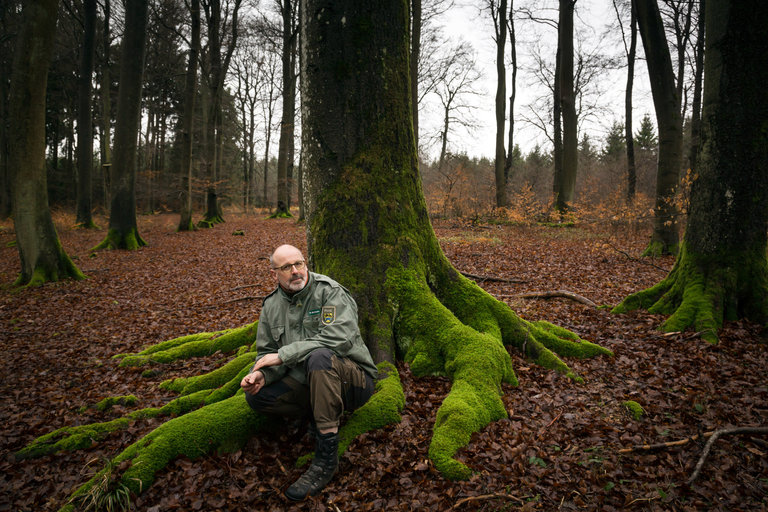 German forester Peter Wohlleben, author of “The Hidden Lives of Trees,” writes (and speaks – see video below) eloquently and matter-of-factly about trees being far more alive, interactive, community-based and capable of far more nuanced communication than our culture generally recognizes.
German forester Peter Wohlleben, author of “The Hidden Lives of Trees,” writes (and speaks – see video below) eloquently and matter-of-factly about trees being far more alive, interactive, community-based and capable of far more nuanced communication than our culture generally recognizes.
Wohlleben’s observations, studies and discoveries dovetail with the work of mycologist Paul Stamets, biologist Suzanne Simard, Ph.D. and other scientists whose research document vast, complex, microscopic (mycchorizal) networks connecting trees, underground, in what function — and even look — like BRAINS for these forest inhabitants, interconnecting trees, fungi, and soil nutrients at the chemical level. But he goes so far as to say trees have… feelings.
But you, dear fellow tree lover, you knew all this intuitively, didn’t you? …that trees and forests — and forest are so much more than just bunches of trees — are alive in profound, mind-bogglingly complex, interconnected ways Western science is only now beginning to study and uncover. We need not wait for such things to be “proven” by science in order to reap the benefits of experiencing these realities first hand. Realities like having love for a forest, even love FROM a forest. Or love for anything, for that matter, since more than a few scientists would reduce love to a series of biological chemical interactions that serve only to perpetuate a species. It is precisely this dispassionate view of the world, of living things, that has in the mess we’re in, having fouled our own environment and leaving too many of us feeling too often alone.
Older trees share nutrients — that’s feeding one another — with younger trees that (who?) need them. Trees, Wohlleben (and other researchers can now document) can alert other trees of attacks by beetles and other insects — they warn their neighbors — by sending chemical signals down to and through their root systems, on to the other trees. And much more.
Some “rational,” “scientific-minded” will likely dismiss all this as personification, the attribution of human feelings upon animate plants (trees) that lack OUR human, unique nervous system. But why is this science’s, uh, root assumption: that other living organisms are less alive if they are not like us? Why are we “highly” evolved and atop a linear or pyramidic or even evolutionary hierarchy of aliveness, and therefore of more/higher/greater value? This is not, I say, the objectivity science purports to trumpet, but something more intrinsically, perhaps uniquely human — simple prejudice. Why is the starting point for all analysis and discussion NOT one of neutrality, that all life has equivalent value unless proven otherwise, without the filter of a humans-are-superior bias? And why is evolutionary complexity the primary determinant for an organism’s worth? Are humans really at the top of a two dimensional measuring stick in a three-dimensional world? And isn’t it really more of a four-dimensional world, assuming you value Albert Einstein’s contribution of the dimension of time, at which trees function at a comparatively slower pace? Is slower of less value? Are we superior because we move faster? Why not argue we are inferior because we are still so admittedly ignorant of other life forms?
Better still, let’s draw precious lessons from trees and forests and not construct a hierarchy in the first place. Let’s put into practice one of nature’s greatest lessons of all; let’s value ALL life as equally precious and interconnected and alive and worth loving.
“The Hidden Lives of Trees” REVIEW by J. Harrison:
I rather would say that he [Peter Wohlleben] observes trees and then suggests that human beings might think about emulating them. If trees were “like us” they would have egos. If trees were like us they would not be cooperating with each other the way they do. They would be struggling so that the fittest could survive. His research and observations assert that Nature is not about individual competition but rather about mutual interdependence. The only reason you are not listening to him is that you believe in the supremacy of the rational scientific ego. Carl Safina may have restricted his discussion to external behaviors, but that does not eliminate the reality that animals have an inner psychic life that is similar although not equivalent to the psychic life of human beings. You would not even have the capability of being an individual without your parents, your family, your society. As a culture we need a Declaration of Interdependence. He is not projecting the human world upon the world of trees. We are both part of the same ecological integrity. But this has been forgotten in the modern world of scientific rationalism. Interdependence, compassion, and equality are Natural principles not merely human values. They are not ideas that can be created and abandoned; they are inherent within the structures of Organic Life. It is Human beings through the worship of reason alone who have anthropomorphized themselves out of interdependence with all life and the living environment. By asserting our rational superiority, we have cut ourselves off from our brotherhood with the living Earth. By focusing on the interdependence between trees in a forest, Wohlleben while scientifically asserting how trees function together, also intuits that we might benefit from living more in harmony with each other; and he makes the attempt to make us see how we might be much better off if we lived in harmony with the living systems of the Earth itself. There is more to Heaven and Earth than Science, Horatio.
VIDEO of Peter Wohlleben 2016 interview on Skavlan (Norwegian-Swedish TV talk show hosted by Norwegian journalist Fredrik Skavlan):
“Intelligent Trees” documentary film TRAILER, with Peter Wohlleben (and Suzanne Simard). Trees are much more alive, and have much more in common with us humans that most of us think…

